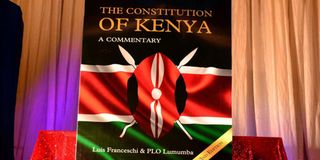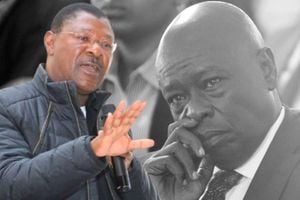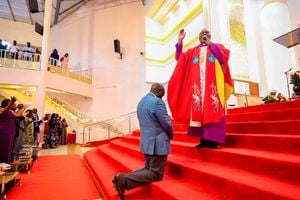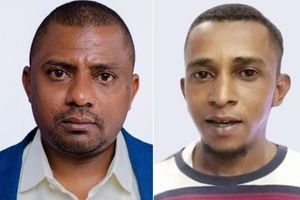It’s time to build consensus on constitution for public good

A dummy copy of the book titled The Constitution of Kenya.
What you need to know:
- Some 49 per cent of Kenyans fear the police more than poverty.
- Between 1992 and 1997, the demand for a new Constitution gathered traction, especially under the National Convention Executive Committee.
The Kenya National Commission on Human Rights and other like-minded organisations have unveiled a report titled ‘Katiba at Ten: Distressed yet Defiant, A Citizens’ Scorecard on the First Decade’. The report reveals that Kenyans are disillusioned a decade into the new constitution.
Findings from the Katiba poll show that only 23 per cent of the respondents are satisfied with the implementation of the Constitution. Although Kenyans have embraced devolution, 87 per cent of those polled believe devolution has fueled graft and misuse of public resources. Some 49 per cent of Kenyans fear the police more than poverty. And tellingly, 60 per cent of the respondents support the implementation of the Constitution instead of its amendment.
How can citizens in only one decade become so disenchanted with a constitution touted as one of Africa’s most progressive?
During the independence constitutional negotiations, the Kenya African National Union (Kanu) supported a centralised system of government while Kenya African Democratic Union (Kadu) advocated for an autonomous Majimbo or regional framework. Because the colonial government supported Kadu, Kanu yielded to its adversary’s position, knowing it would subsequently amend the Constitution.
Regional governments
During Jomo Kenyatta’s and Daniel Arap Moi’s rule, the 1963 multiparty Constitution was repeatedly amended until it became a one party Constitution. Regional governments and equitable sharing of resources were scrapped.
Kenya was made a one -party State. Both the national assembly and judiciary were muzzled. Detention without trial was introduced. The imperial presidency became the norm. Elections were managed by the provincial administration.
Although, from 1966, Jaramogi Oginga became the symbol of the opposition’s crusade for Kenya’s return to democracy, the real agitation for change gained momentum in 1980s and particularly after the 1988 mlolongo or queue voting elections. The catalyst for this shift was the fall of the Berlin Wall and reversal of communism in the Soviet Union and China.
Intellectuals, students, civil society activists and the political opposition coalesced around several protest movements, notably the Forum for Restoration of Democracy (Ford), which, through demonstrations, forced Moi to restore multiparty democracy in 1991.
Between 1992 and 1997, the demand for a new Constitution gathered traction, especially under the National Convention Executive Committee (NCEC). This pro-democracy lobby consisted of representatives from civil society, political opposition and the faith sector.
As a consequence of Kenyatta and Moi marginalising the political opposition, the latter’s main preoccupation became how to create a system which guaranteed their access to power. The civil society’s focus was a total overhaul of the system as their clarion call of No Reforms, No Elections suggested. Both underdogs entered into a marriage of convenience in pursuit of their objectives.
Constitutional change
When constitutional change became imminent, Moi and Kanu favoured further amendment of the existing Constitution by Parliament, not the promulgation of a new one by citizens. He believed this would give him control over the reform process. Kanu curtailed facilitative civic education. Moi was to famously quip that the ordinary person — Wanjiku — knew nothing about the Constitution.
From 1997 to 2008, civil society and the political class contested on the best way to draft the new supreme law. The politicians preferred a process they would control whereas the civil society popularised constitution-making from below, in which all Kenyans had a right to be makers of their Constitution.
After the 1997 demonstrations, Moi grudgingly welcomed the Inter-Parties Parliamentary Group (IPPG) amendments whose basic content was developed by the reform movement but passed in Parliament. Although civil society rejected them, these reforms opened the democratic space.
The IPPG allowed the opposition to hold public meetings without interference from the provincial administration. Both the opposition and the government side appointed members of the electoral commission.
At the close of Moi’s last term, he appointed the Yash Pal Ghai commission to spearhead constitution-making. He ingeniously made sure that a new Constitution would not materialise during his tenure. However, the National Constitutional Conference or Bomas delegates were selected during his reign after Raila Odinga had joined his government.
Public participation
Most of those who presented views to the Ghai commission were politicians, civil society activists, community opinion leaders and, to a lesser extent, ordinary Kenyans. Full-fledged public participation had not yet taken root. Hence one could argue that the initial Constitution of Kenya Commission draft of September 2002 did capture views of Kenyans, especially the middle class.
The National Constitutional Conference adopted the Bomas Draft in 2004. Thereafter it was substantially amended and passed by Parliament, and subsequently presented to the 2005 referendum but defeated.
After the 2007/8 electoral violence, a constitutional amendment to introduce the positions of prime minister and two deputies was initiated. The unsuccessful 2005 draft had similar executive positions.
The new Nzamba Kitonga Committee of Experts produced the 2009 Harmonized Draft after consulting key stakeholders engaged in constitution-making. Ultimately, a parliamentary select committee co-chaired by the then deputy prime minister Uhuru Kenyatta representing Mwai Kibaki and William Ruto representing Raila Odinga produced the Revised Harmonized draft which was passed in Parliament without amendments.
From 2010 to the present, the ruling elite has been unenthusiastic in implementing the letter and the spirit of the constitution. For example, county government functions and resources have consistently been withheld by the national government. The Council of Governors has severally challenged unconstitutional legislation in courts.
Citizen sovereignty and her/his rights have not been habitually respected. Police brutality is a routine affair. Electoral justice is a mirage. Community land rights are denied. Youth rights and the gender principle in representation are not implemented. Abuse of office and lack of integrity are common place.
Parliament, the judiciary and constitutional commissions are often emasculated by the executive. It is, therefore, evident that the 2010 constitution faces serious implementation challenges.
In early 1990s there was the clamour for repeal of section 2A of the constitution. Then followed the insistent call for Wanjiku-driven Constitution. Today there are two parallel quests: the implementation of the 2010 Constitution - Tekeleza Katiba - and the amendment of the 2010 Constitution.
It is time to build a new national consensus which promotes our public collective good.





